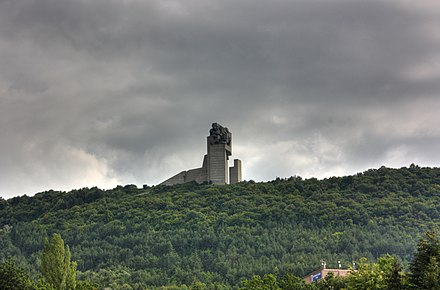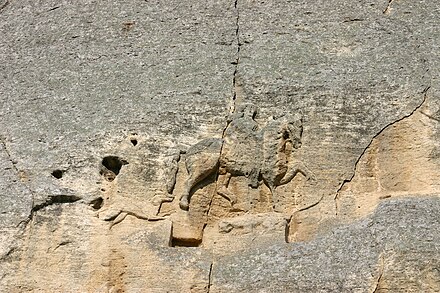Shumen - city in Bulgaria
Shumen (Bulgarian: Шумен) is a city in northeastern part of Bulgaria.


Get in
Shumen Railway Station is located east of the city centre.
Get around
One can get around the town well by foot, bike or taxi. Public transport by bus is also possible.
See
- Founders of the Bulgarian State (1300 Years of Bulgaria). A huge Communist-era monument looming over the city. Its most prominent feature is the 1000-ton granite lion topping one of the angular concrete bodies, but there are also cubist-like statues of Bulgarian rulers in its base, as well as some mosaic panes depicting scenes of Bulgarian history. The monument was built on the Shumen Plateau in the early 1980s, as a part of the celebrations of the 1300th anniversary of the establishment of the First Bulgarian Empire (in 681), hence the alternative name. Unlike other monuments of that era, it hasn't been abandoned and charges for admission. The long staircase that connects the monument to the main pedestrian street is also used by the citizens of Shumen for recreation.
- Tombul Mosque, 43.269444°, 26.91°. 2021-09-22
- Kurşun çeşme (fountain). 2021-09-22
- Shumen Fortress, 43.26261°, 26.89465°. 2021-09-22
- Shumen History Museum, 43.27°, 26.9275°. 2021-09-22
Do
Hiking
Cross-country biking
Paragliding
One of the attractions in the city is the sport paragliding. You can see in the pictures in the following site what is paragliding in Sumen : (dead link: December 2020)
Buy
Eat
Drink
Sleep
You can sleep in Hotel Madara (dead link: January 2023) or Hotel Shumen.
If you don't like hotels there are many lodgings in the city.
Connect
Nearby

- Madara Rider (Madara Horseman). An ancient bas-relief of a horseman spearing a lion, carved into the limestone cliffs of the Madara Plateau near the village of Madara, Shumen Province. One of the symbols of Bulgaria (it's depicted on the back side of low-denomination coins) and the centerpiece of the Madara Archeological Reserve, which also includes a very small museum, the Madara Fortress on top of the cliffs, several caves and other ruins.
- Ruins of Pliska. An archeological reserve that contains the ruins of the first capital of the First Bulgarian Empire, next to the modern village with the same name. Pliska was established in the 9th century, and it's notable for a number of historical events, including being sacked and burned by the Byzantine Emperor Nikephoros I (which lead to his death and his skull being turned into a drinking cup) and being the place where the Bulgarian ruler Boris I was baptized and started the Christianization of Bulgaria. The reserve includes a small museum; the ruins of the Great Basilica are several hundred meters north of the parking lot at the entrance of the fortress, along a paved road.
- Ruins of Preslav. Another archeological reserve. The ruins of medieval Preslav are south of the modern small town of Veliki Preslav; the reserve's archeological museum is on the road between the town and the ruins. Preslav became the second capital of the First Bulgarian Empire in 893, when Simeon I (Simeon the Great) decided to move his court there. It also became the center of the Pliska-Preslav Literary School, a circle of scholars who created the Cyrillic alphabet. A notable sub-ruin within the reserve is the unusually shaped Round (or Gold) Church of Preslav.
Go next
- Southwest of Shumen, close to Kotel, there is a nice village, Medven, with old wooden houses, a nice little waterfall, and a good restaurant and hotel (30 leva for a double room).
Shumen
shumen.bgObshtina Shumen
2nd-order administrative division
Shumen
Primary administrative division